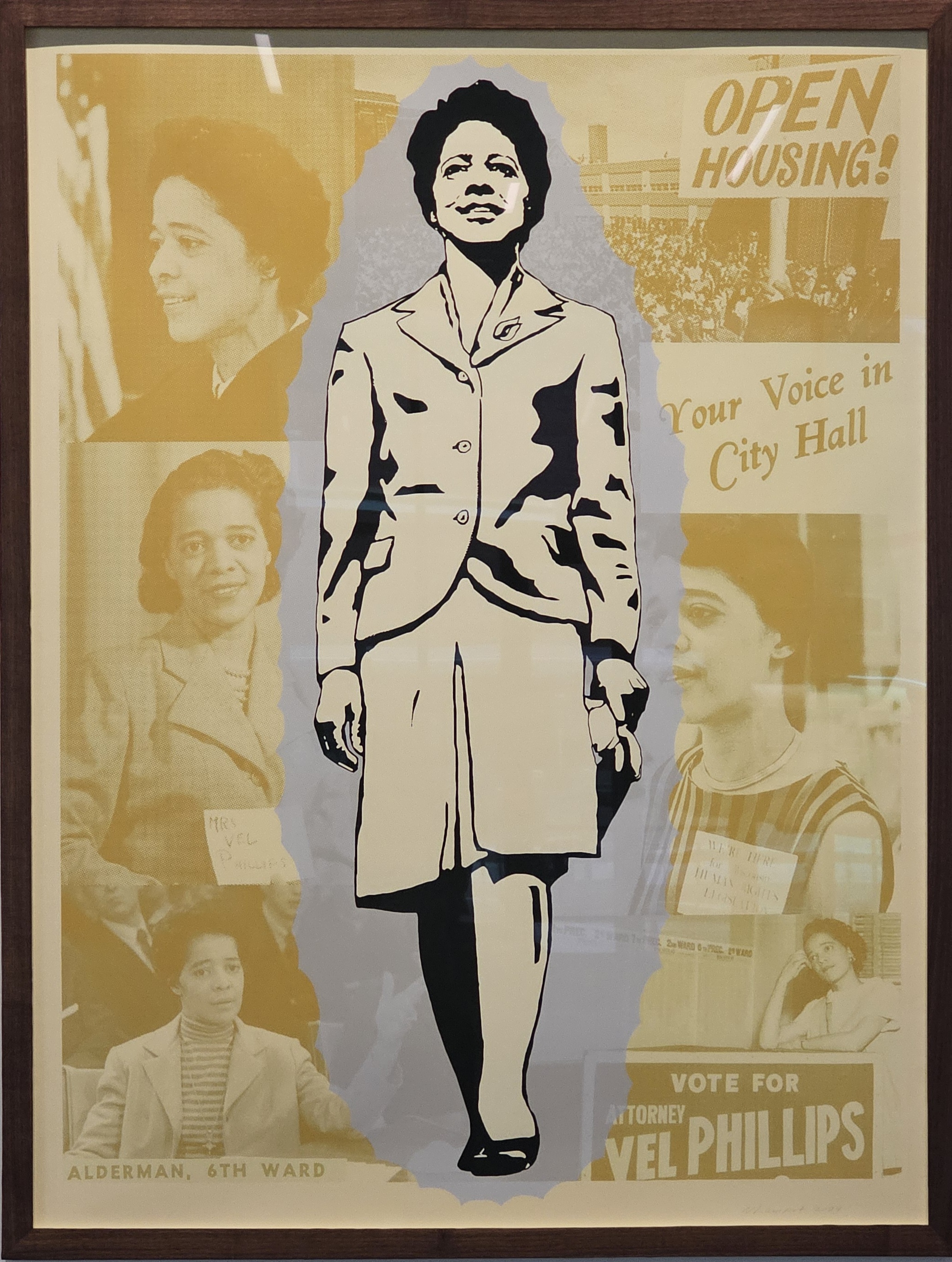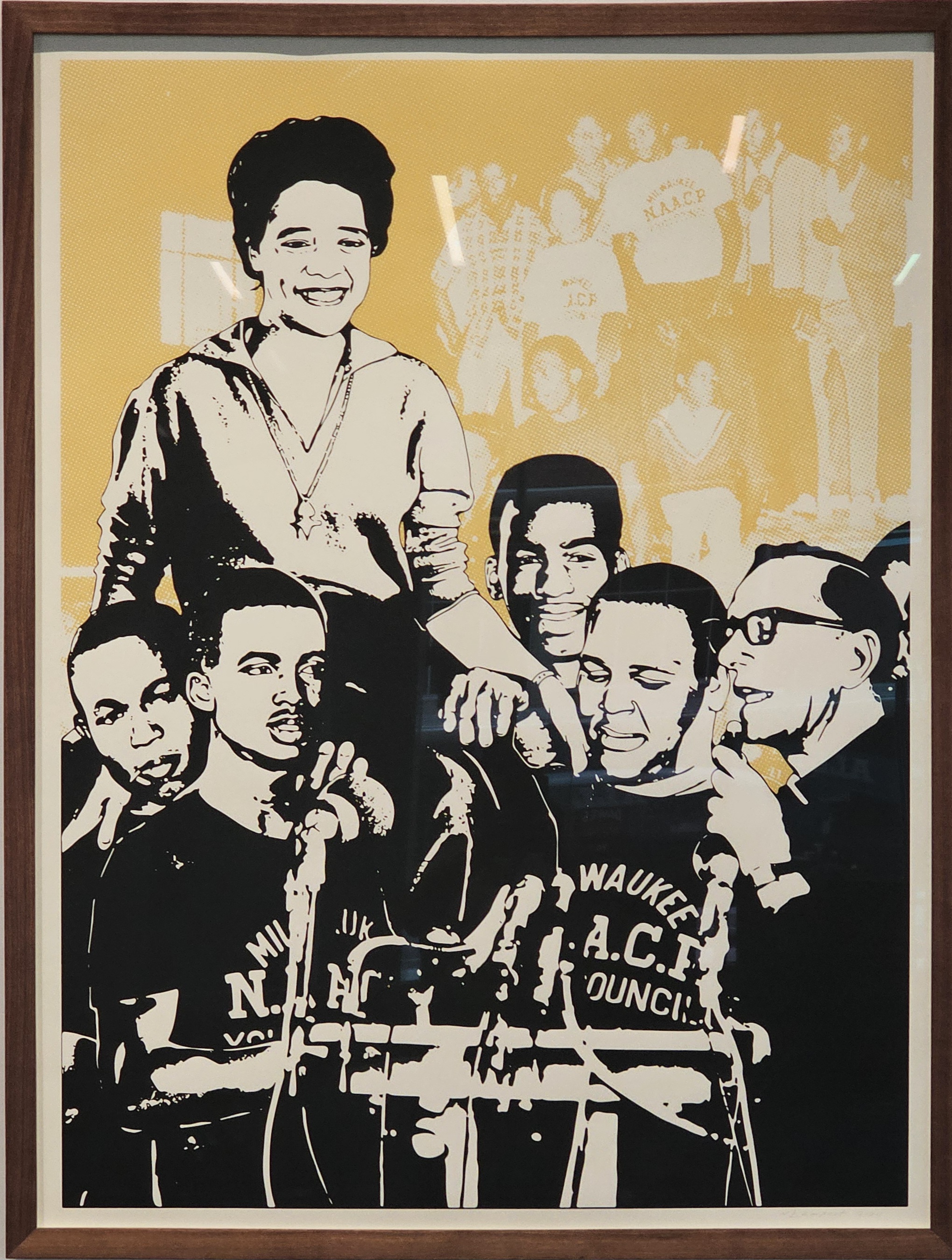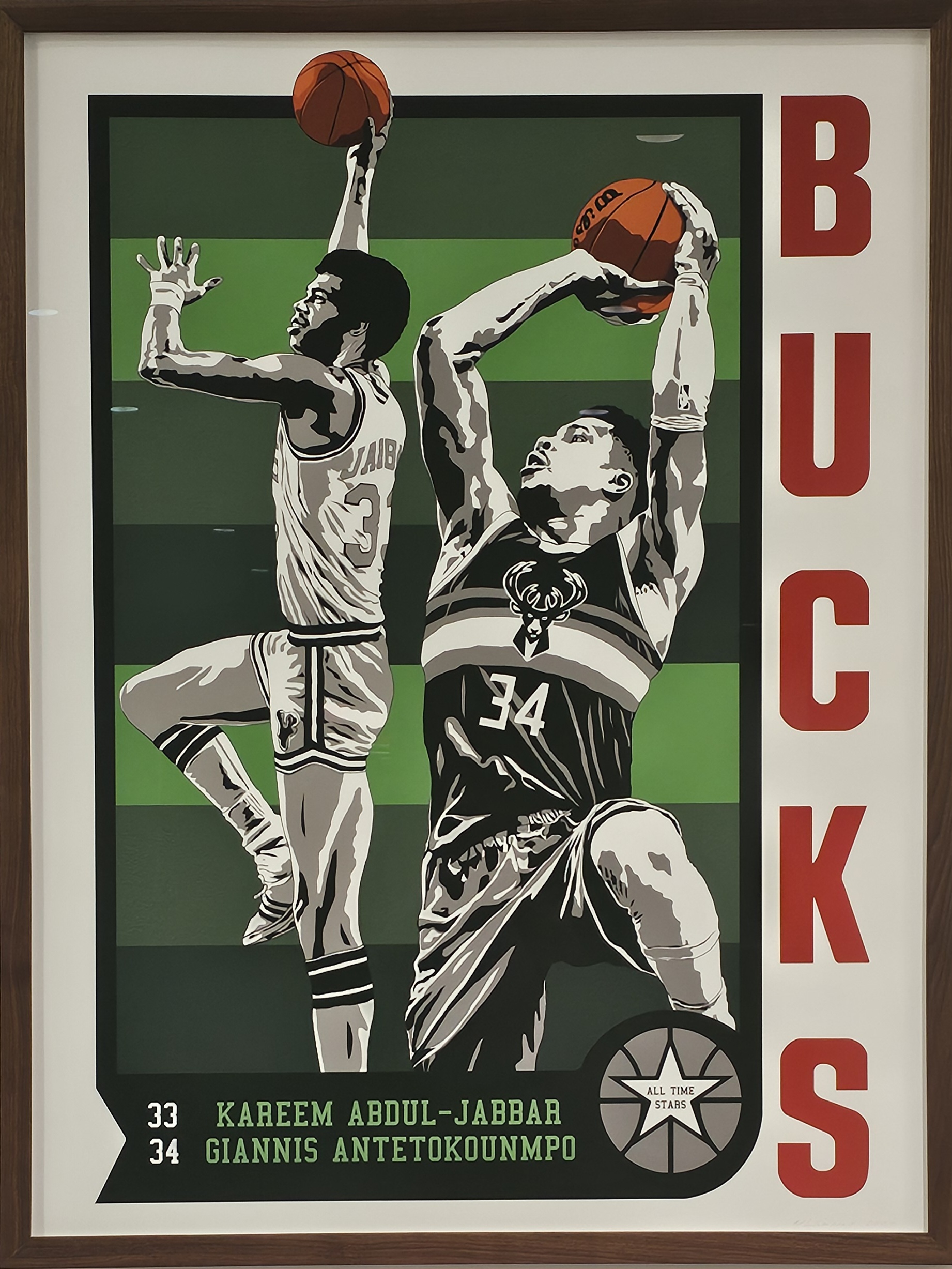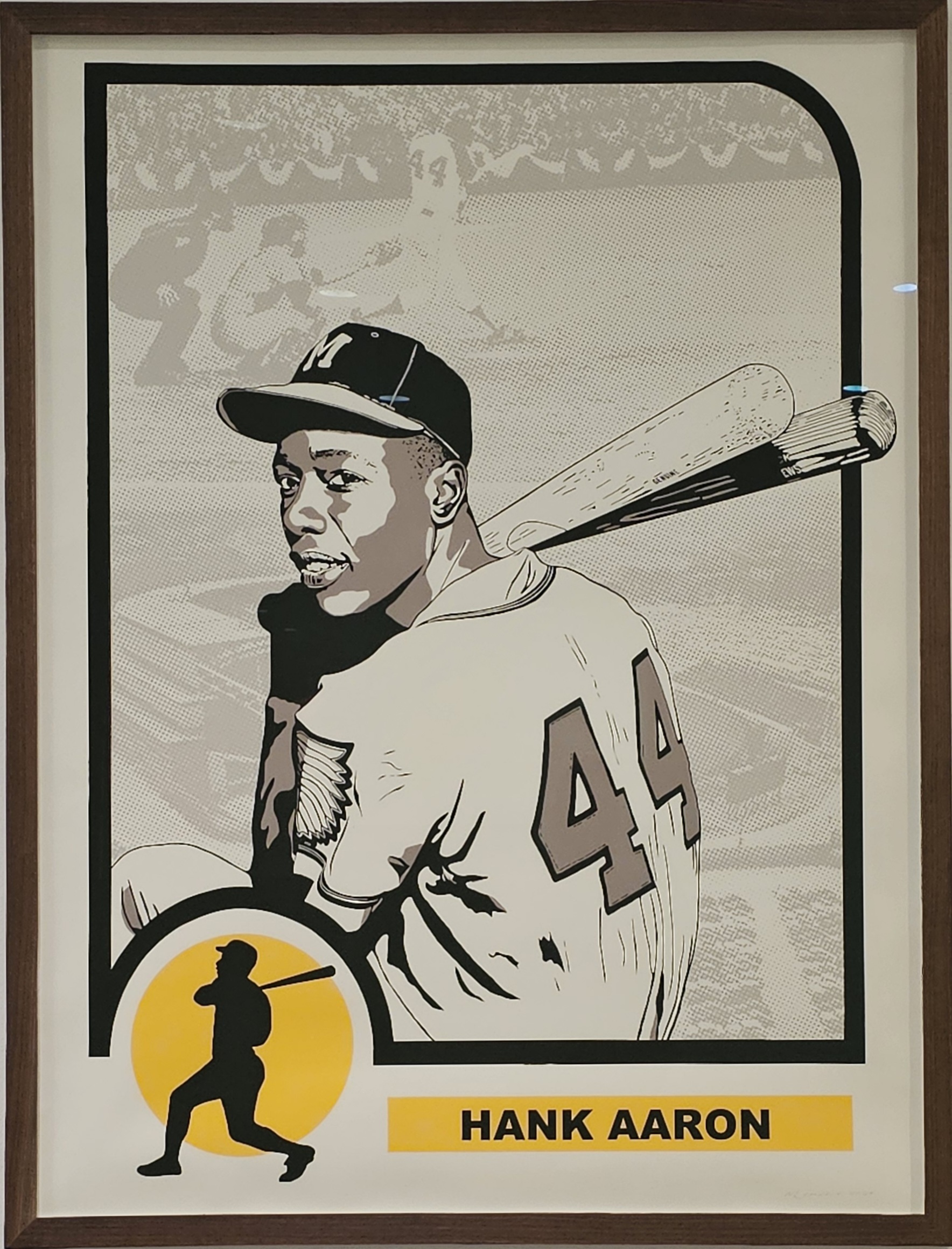Nicolas Lampert
Vel R. Phillips

In Vel R. Phillips, Nicolas Lampert has created digital prints of Vel R. Phillips, the first African American woman to serve on Milwaukee’s Common Council, Milwaukee County’s first woman judge and a life-long fighter for social justice.
Meant to be viewed as a set, the artist pays tribute to Phillips by creating two digital prints depicting her in her trail-blazing roles and as a focal point of Milwaukee’s fair housing movement. The prints were designed using Adobe Illustrator and Photoshop. For the printing, Lampert collaborated with the head of Photography at UW-Milwaukee, Joseph Mougel to color correct every individual pixel before printing to museum quality canvas using archival inks.
Information about Vel R. Phillips
Vel R. Phillips (1924–2018), born Velvalea Rodgers, was a woman of many firsts. In 1951, she became the first African American woman to graduate from UW-Madison Law School. In 1956, she became the first African American and first woman alderman to be elected to the Common Council of Milwaukee. In 1971, she became the first woman judge to be appointed in Milwaukee County and the first African American to serve in Wisconsin’s judiciary. In 1978, she became the first African American and the first woman elected to a statewide executive office when she became Secretary of State of Wisconsin.
Her legacy as a Civil Rights leader took shape when she was elected to the Common Council in 1958 and when she introduced the Phillips Housing Ordinance in 1962 – a bill to outlaw housing discrimination in Milwaukee. The bill was defeated 18-1 by her all-white, male colleagues, with the lone vote in favor being her own. She would re-introduce the bill three additional times, only to have it defeated each time.
The need for a fair housing ordinance was of critical importance. People of color were shut out from living in 90% of the city of Milwaukee. The suburbs were equally segregated and had been closed off for decades via discriminatory housing covenants.
Phillips Fair Housing ordinance passed the Common Council after years of marching and organizing and a series of national events: the assignation of Rev. Dr. Martin Luther King Jr. on April 4, 1968, and the congressional passage of the Fair Housing Act of 1968 six days later. Later that month, the Common Council, passed the Fair Housing Ordinance. The work of Phillips and the Open Housing movement in Milwaukee had a profound national impact. It influenced the congressional fair housing debates and led to the enactment of the Fair Housing Act in 1968.
Vel R. Phillips and the N.A.A.C.P Youth Council

In Vel R. Phillips and the N.A.A.C.P. Youth Council, Nicolas Lampert has created digital prints of Vel R. Phillips, the first African American woman to serve on Milwaukee’s Common Council, Milwaukee County’s first woman judge and a life-long fighter for social justice.
Meant to be viewed as a set, the artist pays tribute to Phillips by creating two digital prints depicting her in her trail-blazing roles and as a focal point of Milwaukee’s fair housing movement. The prints were designed using Adobe Illustrator and Photoshop. For the printing, Lampert collaborated with the head of Photography at UW-Milwaukee, Joseph Mougel to color correct every individual pixel before printing to museum quality canvas using archival inks.
Information about the Open Housing Movement
Vel R. Phillips advocacy for a Fair Housing Ordinance took place in the Common Council and the Open Housing movement in Milwaukee – led by the N.A.A.C.P. Youth Council and highlighted by 200 consecutive nights of marches from 1967 to 1968.
After the Phillips Housing Ordinance bill was rejected by the Common Council, the N.A.A.C.P. Youth Council offered their assistance. They picketed the homes of aldermen who voted down the ordinance, a tactic that Phillips supported, though she did not join in. “I can talk to them,” she explained at the time. “I don’t have to picket them.” She, did, however volunteer to march with the Youth Council.
On Monday, August 28,1967 Father James Groppi and the Youth Council called for a march from Milwaukee’s north side, across the 16th Street Viaduct into the nearly-all white south side to Kosciuszko Park. Marchers were met by crowds of thousands of white counterdemonstrators, who hurled rocks, bottles, and racial epitaphs at the 200-plus marchers. As the days and weeks continued counterdemonstrators grew to 10,000-13,000 people. The police provided little-to-no protection to the 200-plus marchers.
The movement was undeterred by both counterdemonstrators and the arrival of winter when temperatures dipped below zero degrees. The Youth Council marched 200 consecutive nights between August 1967 and March 1968 to demand an open housing ordinance be enacted. The ordinance that Vel R. Phillips had introduced to the Common Council starting in 1962 was finally passed on April 30,1968.
Kareem Abdul-Jabbar / Giannis Antetokounmpo

In this tribute to two Milwaukee Bucks legends, Kareem Abdul-Jabbar and Giannis Antetokounmpo, Nicolas Lampert again uses the concept of the traditional sports trading card. Both superstars brought championships to Milwaukee, but it is their personal stories and commitment to social justice that inspired Lampert to feature them.
Departing from his use of the muted colors of off-white, black and yellow for his depictions of Vel R. Phillips and Hank Aaron, Lampert chose to use shades of green and red that have long been associated with the Bucks. The print was designed using Adobe Illustrator and Photoshop. For the printing, Lampert collaborated with the head of Photography at UW-Milwaukee, Joseph Mougel to color correct every individual pixel before printing to museum quality canvas using archival inks.
Information about Kareem Abdul-Jabbar
Kareem Abdul-Jabbar, born Lou Alcindor in 1947 in Harlem, New York, was a basketball star at a young age. He led Power Memorial to seventy-one consecutive wins and three straight New York City Catholic championships. His dominance continued at UCLA where he led the Bruins to three consecutive national championships under coach John Wooden. At UCLA, he earned a BA with a major in history. He also studied aikido and Jeet Kune Do (a hybrid martial art) under Bruce Lee in Los Angeles.
Abdul-Jabbar was the first overall draft pick for the Milwaukee Bucks in 1969, a team that had been established in 1968. He, along with Oscar Robertson, led the Bucks to their first NBA championship in 1971. That same year he won his first MVP award. He spent six years with the Bucks until he demanded a trade to the Los Angeles Lakers in 1975 during which time the team won five additional NBA championships.
Abdul-Jabbar became politicized during the Harlem riot of 1964 which occurred after the fatal shooting of fifteen-year-old African American James Powell by a New York City police officer. In 1967, Abdul-Jabbar was the only college athlete to attend the Cleveland Summit – a meeting of prominent black athletes who gathered in support of Muhammad Ali and his refusal to fight in the Vietnam War. The following year, Abdul-Jabbar boycotted the Summer Olympics in Mexico City to protest American racism. That same year he converted to Sunni Islam and adopted the Arabic name Kareem Abdul-Jabbar.
During his time in the NBA Abdul-Jabbar was famous for his skyhook shot and leading his teams to championships. His post-NBA career was just as impressive. He became a best-selling author, historian, actor and filmmaker, producing books and documentaries – often about unsung African American heroes.
Information about Giannis Antetokounmpo
Giannis Antetokounmpo was born in Athens, Greece in 1994. His parents, Charles and Veronica, immigrated to Greece in 1991 from Lagos, Nigeria. Although Giannis and three of his four brothers – Thanasis, Kostas, and Alex – were born in Greece, they were not granted Greek citizenship. For the first eighteen years of his life, Giannis could not travel outside the country and was effectively stateless – lacking citizenship from both Greece and Nigeria. The Antetokounmpo brothers lived under the constant threat of their parents being deported to Nigeria. Giannis was eventually issued Greek citizenship on May 9, 2013, less than two months before the NBA draft.
In Greece, Giannis played in the semi-pro Greek B Basket League (Third Division) during the 2011–12 season and with the Greek A2 League the following season. His skillset and size put him on the radar of NBA scouts. He was selected 15th overall by the Milwaukee Bucks in the 2013 NBA draft. His family joined him in Milwaukee the following year after a long, difficult process to procure their visas. In November 2013, Giannis had told his family that if they couldn’t come to the U.S., he would return to Greece.
In 2019 and 2020 Giannis was voted the league MVP. In 2021, Antetokounmpo, along with Khris Middleton and Jrue Holiday, led the Bucks to their first NBA championship since 1971. Giannis is now considered one of the best players in the history of the NBA.
Today, Giannis holds dual citizenship – Greek citizenship and Nigerian citizenship. His mother, Veronica, and his brother Alex were granted Greek citizenship in 2021, the last two living members of his family to obtain Greek citizenship. In 2017 Giannis and his family established the Charles Antetokounmpo Family Foundation – a charitable foundation established to help refugees, immigrants, and a wide array of needs and causes.
Hank Aaron

Using the iconic layout of a sports trading card, Nicolas Lampert has created a striking image of baseball’s all-time home run leader, Hank Aaron. Lampert chose to honor Aaron not only for the great memories he created for Milwaukee baseball fans, but for the dignity he showed in facing rampant racism during his quest to become the home run king and his lifelong efforts to speak out against racism in sports and society.
The central image has Aaron outfitted in his Milwaukee Braves uniform, who he played for during the first 12 years of his career. The background blends the images of Milwaukee’s old ballpark, County Stadium and the historic photo of Aaron breaking Babe Ruth’s home run record as an Atlanta Brave. The print was designed using Adobe Illustrator and Photoshop. For the printing, Lampert collaborated with the head of Photography at UW-Milwaukee, Joseph Mougel to color correct every individual pixel before printing to museum quality canvas using archival inks.
Information about Hank Aaron
Hank Aaron (1934–2021), born Henry Louis Aaron, is considered one of the all-time great baseball players in history. To many, he is the homerun king.
Hank Aaron played twenty-three MLB seasons from 1954 to 1976 for the Milwaukee Braves, the Atlanta Braves, and the Milwaukee Brewers. He was born in Mobile, Alabama under racial segregation and played in the Negro American League and the minors until being called up to the Major Leagues in 1954 with the Milwaukee Braves. In 1957, Aaron helped lead the Milwaukee Braves to a World Series championship. After the 1965 season, the Braves moved to Atlanta. Each season Aaron continued to hit thirty-plus homeruns. Babe Ruth’s homerun record of 714 was in sight.
On April 8, 1974, in front of a crowd of 53,775 at Atlanta-Fulton County Stadium, Hank Aaron hit homerun number 715, breaking one of the most celebrated records in all of sports. The leadup to the breaking of the homerun record should have been a moment of national celebration. Instead, it was one where racism stained the nation. Aaron received mountains of hate mail, death threats, and needed constant security. Anthony Castrovince writes, “Aaron encountered that discrimination with calm, with grace, with honesty and with optimism that one day we could be better. Those are the qualities – far beyond his home run tally – that many will remember him for.”
Aaron finished his career with the Milwaukee Brewers. He hit his final home run on July 20, 1976 (number 755) – a record that stood for thirty-one years. Always quiet and shy, Aaron gave back to the community through volunteering, financial donations, and later through his own charity, the Hank Aaron Youth Fund, which gave scholarships to hundreds of Milwaukee students.

About Nicolas Lampert
Nicolas Lampert is a Milwaukee-based interdisciplinary artist, author and instructor whose work focuses on themes of social justice and ecology. He works primarily with three organizations to help unions, organizations and movements create positive social, environmental and political change by incorporating art into their messaging. Justseeds Artists’ Cooperative is a worker-owned printmaking cooperative of over forty artists in North America that formed in 2007. His work with Art Build Workers, a group of seven artists designers, photographers and educators based in Milwaukee, sees him work locally and travel around the country organizing multi-day art builds. Lampert also works as a part time art organizer for Voces de la Frontera, Wisconsin’s largest immigrants’ rights organization.
Lampert’s artwork is in the permanent collections of the Museum of Modern Art, the Milwaukee Art Museum, the Library of Congress and over sixty archives and special collections around the world. His first book A People’s Art History of the United States: 250 Years of Activist and Artists Working in Social Justice Movements was published by The New Press in 2013.
Lampert received a BFA from the University of Michigan and an MFA from the California College of the Arts. He currently serves as a full-time faculty member in the Writing and Critical Thinking area in the Department of Art and Design at the University of Wisconsin-Milwaukee.
Q&A with Nicolas Lampert
